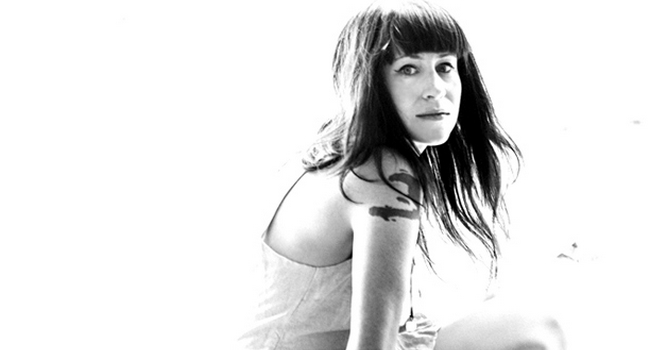 For someone with such a far out imagination, Steve Walters is a fairly down to earth guy. He’s humble about his background and the initial level of talent he brought to his screen printing enterprise, Screwball Press.
For someone with such a far out imagination, Steve Walters is a fairly down to earth guy. He’s humble about his background and the initial level of talent he brought to his screen printing enterprise, Screwball Press.
Now, 22 years later, Walters is without question the godfather of the Chicago poster scene, if not its grandfather, a title he would undoubtedly object to, given his relative youth, vigorous energy and evident passion for this artistic medium that he seemingly has fallen into creating.
Walters started in 1990, making posters for local Chicago bands, with his roster eventually including Shellac, the Coctails, Wilco, Pavement, Alejandro Escovedo, Apples In Stereo, Andrew Bird and Big Star. His work has been featured in art exhibits and poster art books, including “The Art of Modern Rock” and “Gig Posters, Vol. 1.”
During a visit to his studio in Chicago’s North Center neighborhood he describes how it all began. After getting laid off as a grocery store manager, while living, as he calls it, “too close” to an arts supply store he started “messing around with printing.”
Although he grew up in the Chicago suburbs, he started playing in bands during his college years in Iowa City, but as he’s the first to admit he was not a very skilled or talented musician. After moving to Chicago he played in Number One Cup, Yum-Yum and auditioned unsuccessfully to play bass in Red Red Meat (“They were kind enough to tell me “No thank you” right away, rather than letting me embarrass myself for months,” he says).
Fortunately, Walters had friends in bands and hung out at the (sadly since shuttered) Lounge Ax in Lincoln Park, which influenced him to start making flyers with a xerox machine to support those friends’ bands. ” I tried to get color on them by painting them with fluorescent paints, and then I started block printing with linoleum blocks,” Walters says. “Then I got a job to do like 2,000 magazine covers for a friend of mine’s magazine called Speed Kills, and I started out block printing them, and after 48 hours straight working on that, I went to the store and bought a kit and started screen printing.”
In retrospect, he realizes that that particular project took the most time of any that he can recall, “because I didn’t know what I was doing and I had just bought the kit and was printing in my living room.” Not only was the “Speed Kills” project tiring, but it could have killed him.
“I was using these inks that the magazine guy found in his basement, and after I was done I looked at them and it said they were all lead-based,” Walters says with a laugh.
When asked what inspired him to start a business, he says, “Have I?” and laughs again. “I have I guess. It was never intended to turn into anything.” Explaining that during the late ’80s and early ’90s he was surrounded by fledgling magazines and record labels, adding “Whether they were actually producing anything or not, it was fun to try things, and putting a name to it and acting like you were a corporation, so after I started printing for people it was kind of a joke that I named myself Screwball Press, because I was honest; I don’t know what I’m doing.”

He gives credit to the supportive musical and artistic environment of Chicago, in particular, saying the staff of Lounge Ax “were amazingly encouraging people, and I think they really spread my name around and got me a lot of business from other places.”
Even so, he still emphasizes his perceived lack of knowledge stating that he felt in over his head all through the ’90s. “I mean in ’94, ’95 I was working for Capitol Records and other major companies like that, but I got so busy that I just kept working and working and never really thought about it.”
It’s easy to understand why Walters may have felt over his head. He didn’t study art in college, and never had any art or design training outside of high school, although he he mentions a consistent history in doodling.
“My idea was just to make a big loud thing to put on the streets to get people in to see these bands, and I never really thought much about the art training part of it.”
He’s a fan of “outsider” artists like Wesley Willis, the self-taught people. He’s printed for Howard Finster and has the utmost respect for people “who are just obsessed with what they do and never bothered to study it.”
Additionally, he cites humor as a big source of his inspiration. Walters says that over the years he’s had many different sources of inspiration. “I think I’m informed by the Dadaists, like Duchamp and all those guys, they seemed like they had a really good sense of humor about their work.”
When asked if there are any posters that he’s particularly proud of, he cites a recent poster he did for the band X for a New York City concert: “They’re one of my favorite bands in the world, and I was really happy with the way it came out, and I heard from the band that everyone there liked it too, so that was really gratifying.”
Walter’s creative process is uncomplicated.”Bands usually just say, ‘do what you do,’ and that’s the way I work best. If they want something specific I’m not very good at that. People that illustrate are good at realizing other people’s ideas, I think, but I’m not an illustrator, and I’ve learned over the years to just say no to stuff that’s beyond my capability,” Walters says. “I made a lot of mistakes early on thinking I could do things that I didn’t have the skills for.”
Don’t mistake his self-imposed limitations for a lack of effort though, as he takes an active interest in his clients. “Lately I’ve been trying to listen to the lyrics of the bands to find an image in there that ties in somehow.”
And his work continues to evolve.“I get bored with what I’m doing every 3 or 4 years and I feel like it starts to show in the work, so I start doing something new.” He cites the X poster as an example of what he’s been doing lately, “I’ve been doing my own version of four color process kind of printing with very large half-tone dots,” Walters says.
“I print out a photograph in black and white with four different half tone angles and then go with white paint and block out parts of it that I don’t want to print and then make my films from that.”
In addition to his own work, Walters prints others’ work by providing the design in exchange for paid printing and the right to sell extra posters down the line. “I did some stuff for Wilco early on and I’ve seen those posters on eBay selling for like five or six hundred dollars,” Walters says. “Every time I put something up on eBay I get like $20. I’ve given up on eBay.”
Then there’s his final source of revenue, Screwball Academy. For $300, Walters will spend a day or two half days showing his “students” how to make a screen printed poster; they arrive with line art of what they want to do, and leave with 50 11” x 17” three color prints that they have made themselves. In addition, they have a membership in the Screwball Press co-op for one year. Interested parties can contact him via facebook or via his website (www.screwballpress.com). He makes it clear that Screwball Academy shows students the process, but doesn’t teach you everything. “After twenty-two years, I’m still learning stuff, which is what I like about it.”






